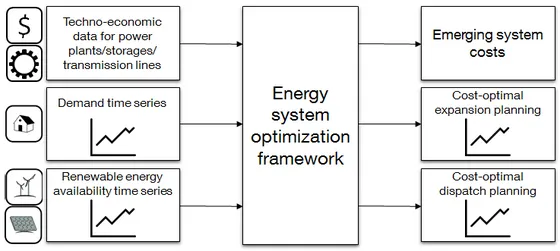Model development for energy systems
Energy system modelling chiefly employs mathematical optimization for determining the cost-optimal energy infrastructure and its operation, under certain boundary conditions depending on a given case study. In mathematical terms, operation of the energy system is presented as an optimization problem; in which the dispatch and/or investment decisions constitute the model variables, the operating conditions for system units and/or emission limitations make up the model constraints. The costs emerging from the decisions taken by the model is represented as the objective function to be minimized.
Challenges and opportunities
Optimization models: Depending on the scale of the analysis, every energy system model portrays a simplified form of the actual system to a certain extent. This stems not only from data inadequacy or the necessity of assumptions, but also the limitations imposed by the computational tools that are used for the modelling. For instance, large-scale, high-resolution energy system models result in large models, which are difficult to handle with conventional usage of computer memory. Implementing realistic operating conditions of conventional power plants such as their start-up costs and minimum part-load behavior, on the other hand, require mixed-integer problem (MIP) representations, which further drastically increase the computational complexity. At this point, the advent of high-performance and parallel computing opportunities enables certain mathematical techniques such as decomposition or dynamic programming as promising solutions.
Social models: In modern energy systems undertaking a transition, the extent of decentralized power generation via households adopting rooftop photovoltaics or communities investing in wind parks is expected to increase. Furthermore, new possibilities emerge for flexibilizing the energy demand through household participation beside industries. These factors underline the importance of understanding the social aspects within the evolution of an energy system; such as the diffusion of new technologies market (e.g. PV, electric vehicles) entering the market, or the response of a society to policy changes (e.g. variable electricity tariffs, FIT’s). To this end, various modelling approaches are employed, including but not limited to multivariate regression/econometrics, systems modelling, and agent based modelling.
Research at the Chair
As in many other fields of research dealing with large amounts of data and intensive processing thereof, the reproducibility and transparency of energy system models are of high importance. Along these lines, open-source tools are developed in the Chair of Renewable and Sustainable Energy Systems (among others urbs, a linear framework for optimal capacity expansion and dispatch planning; and rivus a mixed-integer framework for the extension and dispatch planning of multi-commodity networks). These tools are further refined for improved features, higher flexibility, better ease-of-use, and computational efficiency.
The fields of research being undertaken by the Chair of Renewable and Sustainable Energy Systems on development of energy system models can be summed up as follows:
- Development of open-source tools for generating energy system models
- Intertemporal and dynamic programming of energy system models
- Decomposition techniques and parallel computing applied to energy system models
- Performance evaluation of various modelling libraries and solvers applied to energy system models
- Partial differential equation (PDE)-constrained optimization of energy system models with high-performance computing
- Systems modelling (sociodynamics) of social aspects in energy systems

